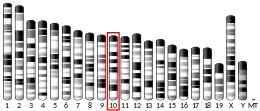TAAR6
Trace amine associated receptor 6, also known as TAAR6, is a protein which in humans is encoded by the TAAR6 gene.[5][6]
| TAAR6 | |||||||||||||||||||||||||||||||||||||||||||||||||||
|---|---|---|---|---|---|---|---|---|---|---|---|---|---|---|---|---|---|---|---|---|---|---|---|---|---|---|---|---|---|---|---|---|---|---|---|---|---|---|---|---|---|---|---|---|---|---|---|---|---|---|---|
| Identifiers | |||||||||||||||||||||||||||||||||||||||||||||||||||
| Aliases | TAAR6, TA4, TAR4, TAR6, TRAR4, taR-4, taR-6, trace amine associated receptor 6 | ||||||||||||||||||||||||||||||||||||||||||||||||||
| External IDs | OMIM: 608923 MGI: 2685074 HomoloGene: 27874 GeneCards: TAAR6 | ||||||||||||||||||||||||||||||||||||||||||||||||||
| |||||||||||||||||||||||||||||||||||||||||||||||||||
| |||||||||||||||||||||||||||||||||||||||||||||||||||
| |||||||||||||||||||||||||||||||||||||||||||||||||||
| |||||||||||||||||||||||||||||||||||||||||||||||||||
| |||||||||||||||||||||||||||||||||||||||||||||||||||
| Wikidata | |||||||||||||||||||||||||||||||||||||||||||||||||||
| |||||||||||||||||||||||||||||||||||||||||||||||||||
Function
TAAR6 belongs to the trace amine-associated receptor family. Trace amines are endogenous amine compounds that are chemically similar to classic biogenic amines like dopamine, norepinephrine, serotonin, and histamine. Trace amines were thought to be 'false transmitters' that displace classic biogenic amines from their storage and act on transporters in a fashion similar to the amphetamines, but the identification of brain receptors specific to trace amines indicates that they also have effects of their own.[7][8] RNA expression analysis shows hTAAR6 is expressed in the hippocampus, where murine TAAR receptors have been shown to be involved with neurogenesis.[9]
Computational modeling suggests TAAR6 can bind to the foul smelling compounds produced by rotting flesh, putrescine and cadaverine.[10]
TAAR6 mutant mice have differences in behavior compared with wild-type mice.[11] Also, they have elevated brain serotonin levels in several brain regions and enhanced hypothermic response to 5-HT1A receptor agonist 8-OH-DPAT.[12]
References
- GRCh38: Ensembl release 89: ENSG00000146383 - Ensembl, May 2017
- GRCm38: Ensembl release 89: ENSMUSG00000045111 - Ensembl, May 2017
- "Human PubMed Reference:". National Center for Biotechnology Information, U.S. National Library of Medicine.
- "Mouse PubMed Reference:". National Center for Biotechnology Information, U.S. National Library of Medicine.
- Borowsky B, Adham N, Jones KA, Raddatz R, Artymyshyn R, Ogozalek KL, et al. (July 2001). "Trace amines: identification of a family of mammalian G protein-coupled receptors". Proceedings of the National Academy of Sciences of the United States of America. 98 (16): 8966–71. doi:10.1073/pnas.151105198. PMC 55357. PMID 11459929.
- Lindemann L, Ebeling M, Kratochwil NA, Bunzow JR, Grandy DK, Hoener MC (March 2005). "Trace amine-associated receptors form structurally and functionally distinct subfamilies of novel G protein-coupled receptors". Genomics. 85 (3): 372–85. doi:10.1016/j.ygeno.2004.11.010. PMID 15718104.
- Duan J, Martinez M, Sanders AR, Hou C, Saitou N, Kitano T, et al. (October 2004). "Polymorphisms in the trace amine receptor 4 (TRAR4) gene on chromosome 6q23.2 are associated with susceptibility to schizophrenia". American Journal of Human Genetics. 75 (4): 624–38. doi:10.1086/424887. PMC 1182049. PMID 15329799.
- "Entrez Gene: TAAR6 trace amine associated receptor 6".
- Katolikova NV, Vaganova AN, Efimova EV, Gainetdinov RR (June 2022). "Expression of Trace Amine-Associated Receptors in the Murine and Human Hippocampus Based on Public Transcriptomic Data". Cells. 11 (11): 1813. doi:10.3390/cells11111813. PMC 9180029. PMID 35681508.
- Izquierdo C, Gómez-Tamayo JC, Nebel JC, Pardo L, Gonzalez A (January 2018). "Identifying human diamine sensors for death related putrescine and cadaverine molecules". PLOS Computational Biology. 14 (1): e1005945. Bibcode:2018PLSCB..14E5945I. doi:10.1371/journal.pcbi.1005945. PMC 5783396. PMID 29324768.
- Kuvarzin S, Leonova E, Efimova E, Gainetdinov R (December 2019). "Identifying the function of trace amine-associated receptor 6 and its role in behavior, physiology and brain neurochemistry". European Neuropsychopharmacology. Elsevier. 29: S93. doi:10.1016/j.euroneuro.2019.09.164. S2CID 209352329.
- Kuvarzin S, Efimova E, Gainetdinov R (December 2021). "TAAR6 mutant mice have changes in the brain serotonin levels and enhanced hypothermic response to serotonin 5-HT1A receptor agonist 8-OH-DPAT". European Neuropsychopharmacology. Elsevier. 53: S212–S213. doi:10.1016/j.euroneuro.2021.10.279. S2CID 245564698.
Further reading
- Cao Q, Martinez M, Zhang J, Sanders AR, Badner JA, Cravchik A, et al. (July 1997). "Suggestive evidence for a schizophrenia susceptibility locus on chromosome 6q and a confirmation in an independent series of pedigrees". Genomics. 43 (1): 1–8. doi:10.1006/geno.1997.4815. PMID 9226366.
- Kaufmann CA, Suarez B, Malaspina D, Pepple J, Svrakic D, Markel PD, et al. (July 1998). "NIMH Genetics Initiative Millennium Schizophrenia Consortium: linkage analysis of African-American pedigrees". American Journal of Medical Genetics. 81 (4): 282–9. doi:10.1002/(SICI)1096-8628(19980710)81:4<282::AID-AJMG2>3.0.CO;2-W. PMID 9674972.
- Borowsky B, Adham N, Jones KA, Raddatz R, Artymyshyn R, Ogozalek KL, et al. (July 2001). "Trace amines: identification of a family of mammalian G protein-coupled receptors". Proceedings of the National Academy of Sciences of the United States of America. 98 (16): 8966–71. doi:10.1073/pnas.151105198. PMC 55357. PMID 11459929.
- Duan J, Martinez M, Sanders AR, Hou C, Saitou N, Kitano T, et al. (October 2004). "Polymorphisms in the trace amine receptor 4 (TRAR4) gene on chromosome 6q23.2 are associated with susceptibility to schizophrenia". American Journal of Human Genetics. 75 (4): 624–38. doi:10.1086/424887. PMC 1182049. PMID 15329799.
- Lindemann L, Ebeling M, Kratochwil NA, Bunzow JR, Grandy DK, Hoener MC (March 2005). "Trace amine-associated receptors form structurally and functionally distinct subfamilies of novel G protein-coupled receptors". Genomics. 85 (3): 372–85. doi:10.1016/j.ygeno.2004.11.010. PMID 15718104.
- Amann D, Avidan N, Kanyas K, Kohn Y, Hamdan A, Ben-Asher E, et al. (February 2006). "The trace amine receptor 4 gene is not associated with schizophrenia in a sample linked to chromosome 6q23". Molecular Psychiatry. 11 (2): 119–21. doi:10.1038/sj.mp.4001752. PMID 16189505. S2CID 43731573.
This article incorporates text from the United States National Library of Medicine, which is in the public domain.




